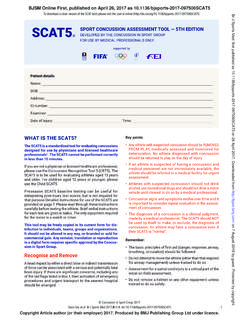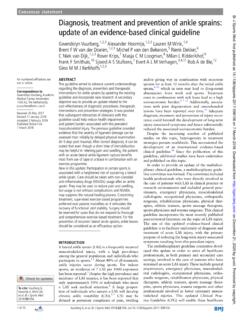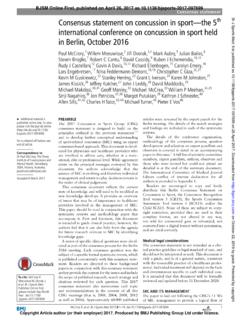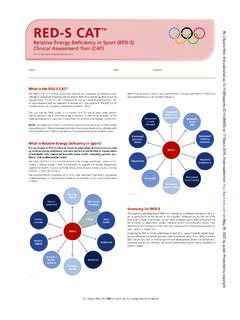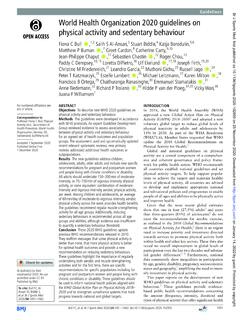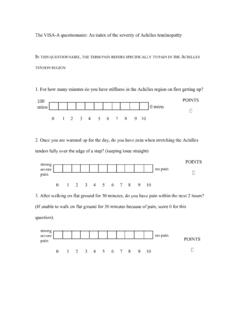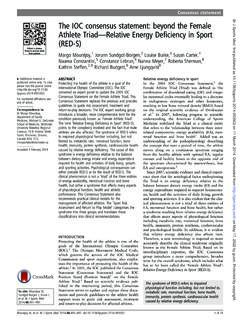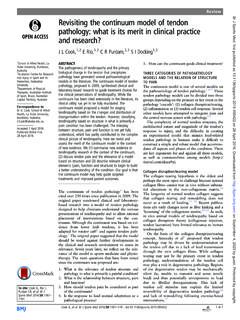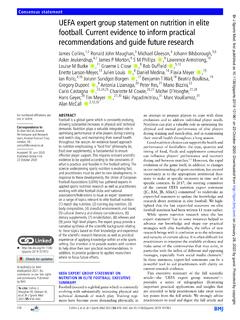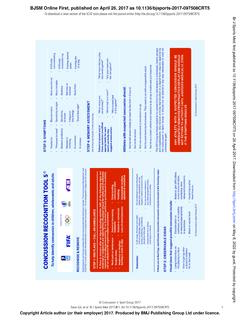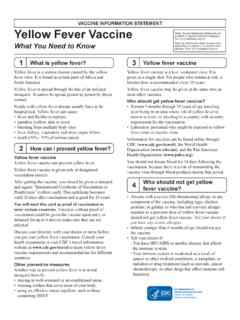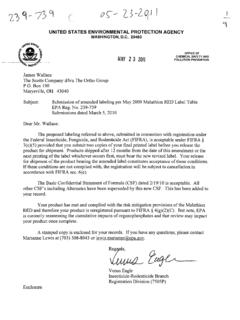Transcription of SCAT3 - bjsm.bmj.com
1 Downloaded from on April 11, 2018 - Published by SCAT3 . Sport Concussion Assessment Tool 3rd edition For use by medical professionals only name Date / Time of Injury: examiner: Date of Assessment: What is the SCAT3 ?1. 1 glasgow coma scale (gCS). the SCAT3 is a standardized tool for evaluating injured athletes for concussion and can be used in athletes aged from 13 years and older. it supersedes the orig- Best eye response (e). inal SCAt and the SCAt2 published in 2005 and 2009, respectively 2. For younger no eye opening 1. persons, ages 12 and under, please use the Child SCAT3 . the SCAT3 is designed for use by medical professionals. If you are not qualifi ed, please use the Sport eye opening in response to pain 2.
2 Concussion recognition tool1. preseason baseline testing with the SCAT3 can be eye opening to speech 3. helpful for interpreting post-injury test scores. eyes opening spontaneously 4. Specifi c instructions for use of the SCAT3 are provided on page 3. If you are not Best verbal response (v). familiar with the SCAT3 , please read through these instructions carefully. this no verbal response 1. tool may be freely copied in its current form for distribution to individuals, teams, incomprehensible sounds 2. groups and organizations. Any revision or any reproduction in a digital form re- quires approval by the Concussion in Sport Group. inappropriate words 3. NOTE: the diagnosis of a concussion is a clinical judgment, ideally made by a Confused 4.
3 Medical professional. the SCAT3 should not be used solely to make, or exclude, oriented 5. the diagnosis of concussion in the absence of clinical judgement. An athlete may have a concussion even if their SCAT3 is normal . Best motor response (m). no motor response 1. extension to pain 2. What is a concussion? Abnormal fl exion to pain 3. A concussion is a disturbance in brain function caused by a direct or indirect force to the head. It results in a variety of non-specifi c signs and / or symptoms (some Flexion / Withdrawal to pain 4. examples listed below) and most often does not involve loss of consciousness. localizes to pain 5. Concussion should be suspected in the presence of any one or more of the obeys commands 6.
4 Following: - Symptoms ( , headache), or glasgow Coma score (e + v + m) of 15. - Physical signs ( , unsteadiness), or GCS should be recorded for all athletes in case of subsequent deterioration. - Impaired brain function ( confusion) or - Abnormal behaviour ( , change in personality). 2 maddocks Score3. Sideline ASSeSSmenT I am going to ask you a few questions, please listen carefully and give your best effort.. Modifi ed Maddocks questions (1 point for each correct answer). indications for emergency management What venue are we at today? 0 1. noTe: A hit to the head can sometimes be associated with a more serious brain injury. Any of the following warrants consideration of activating emergency pro- Which half is it now?
5 0 1. cedures and urgent transportation to the nearest hospital: Who scored last in this match? 0 1. - Glasgow Coma score less than 15 What team did you play last week / game? 0 1. - Deteriorating mental status Did your team win the last game? 0 1. - potential spinal injury - progressive, worsening symptoms or new neurologic signs maddocks score of 5. Maddocks score is validated for sideline diagnosis of concussion only and is not used for serial testing. Potential signs of concussion? if any of the following signs are observed after a direct or indirect blow to the head, the athlete should stop participation, be evaluated by a medical profes- sional and should not be permitted to return to sport the same day if a notes: mechanism of injury ( tell me what happened ?)
6 : concussion is suspected. Any loss of consciousness? Y n if so, how long? . Balance or motor incoordination (stumbles, slow / laboured movements, etc.)? Y n Disorientation or confusion (inability to respond appropriately to questions)? Y n loss of memory: Y n if so, how long? . Before or after the injury?" Any athlete with a suspected concussion should be removed Blank or vacant look: Y n From PlAy, medically assessed, monitored for deterioration Visible facial injury in combination with any of the above: Y n ( , should not be left alone) and should not drive a motor vehicle until cleared to do so by a medical professional. no athlete diag- nosed with concussion should be returned to sports participation on the day of injury.
7 SCAT3 Sport ConCuSSion ASSeSment tool 3 | PAge 1 2013 Concussion in Sport Group 259. Downloaded from on April 11, 2018 - Published by Background Cognitive & Physical Evaluation Name: Date: 4 Cognitive assessment Examiner: Standardized Assessment of Concussion (SAC) 4. Sport / team / school: Date / time of injury: Age: Gender: M F Orientation (1 point for each correct answer). Years of education completed: What month is it? 0 1. Dominant hand: right left neither What is the date today? 0 1. How many concussions do you think you have had in the past? What is the day of the week? 0 1. When was the most recent concussion? What year is it? 0 1. How long was your recovery from the most recent concussion?
8 What time is it right now? (within 1 hour) 0 1. Have you ever been hospitalized or had medical imaging done for Y N Orientation score of 5. a head injury? Have you ever been diagnosed with headaches or migraines? Y N Immediate memory Do you have a learning disability, dyslexia, ADD / ADHD? Y N List Trial 1 Trial 2 Trial 3 Alternative word list Have you ever been diagnosed with depression, anxiety Y N elbow 0 1 0 1 0 1 candle baby finger or other psychiatric disorder? apple 0 1 0 1 0 1 paper monkey penny Has anyone in your family ever been diagnosed with Y N. any of these problems? carpet 0 1 0 1 0 1 sugar perfume blanket Are you on any medications? If yes, please list: Y N saddle 0 1 0 1 0 1 sandwich sunset lemon bubble 0 1 0 1 0 1 wagon iron insect Total SCAT3 to be done in resting state.
9 Best done 10 or more minutes post excercise. Immediate memory score total of 15. Symptom Evaluation Concentration: Digits Backward List Trial 1 Alternative digit list 3 How do you feel? 4-9-3 0 1 6-2-9 5-2-6 4-1-5. You should score yourself on the following symptoms, based on how you feel now . 3-8-1-4 0 1 3-2-7-9 1-7-9-5 4-9-6-8. 6-2-9-7-1 0 1 1-5-2-8-6 3-8-5-2-7 6-1-8-4-3. none mild moderate severe 7-1-8-4-6-2 0 1 5-3-9-1-4-8 8-3-1-9-6-4 7-2-4-8-5-6. Headache 0 1 2 3 4 5 6. Total of 4. Pressure in head 0 1 2 3 4 5 6. Neck Pain 0 1 2 3 4 5 6 Concentration: Month in Reverse Order (1 pt. for entire sequence correct). Nausea or vomiting 0 1 2 3 4 5 6. Dec-Nov-Oct-Sept-Aug-Jul-Jun-May-Apr-Mar -Feb-Jan 0 1.
10 Dizziness 0 1 2 3 4 5 6. Concentration score of 5. Blurred vision 0 1 2 3 4 5 6. Balance problems 0 1 2 3 4 5 6. Sensitivity to light 0 1 2 3 4 5 6. Sensitivity to noise 0 1 2 3 4 5 6 5 Neck Examination: Feeling slowed down 0 1 2 3 4 5 6 Range of motion Tenderness Upper and lower limb sensation & strength Feeling like in a fog 0 1 2 3 4 5 6. Findings: Don't feel right 0 1 2 3 4 5 6. Difficulty concentrating 0 1 2 3 4 5 6. Difficulty remembering 0 1 2 3 4 5 6 6 Balance examination Fatigue or low energy 0 1 2 3 4 5 6. Do one or both of the following tests. Confusion 0 1 2 3 4 5 6. Footwear (shoes, barefoot, braces, tape, etc.) Drowsiness 0 1 2 3 4 5 6. Trouble falling asleep 0 1 2 3 4 5 6 Modified Balance Error Scoring System (BESS) testing5.
